How did the idea for pitchIN start?
This was in 2012 and my business partner Sam Shafie and I wanted to start something for ourselves. At that time, we already had an accelerator programme, which we still run. Crowdfunding had not become FinTech yet because it was more a rewards-based system, like Kickstarter. FinTech is usually referred to as the spaces where banks usually operate, and it is highlyregulated space. So, we started pitchIN and you could say that we were the first to bring this idea of crowdfunding to Malaysia. We did some cool rewards projects (TeeSomethingNice), which got us some good publicity.
About two years later, the Securities Commission started looking into this idea of FinTech, equity crowdfunding (ECF) in particular, which had become quite big in the UK at that time. And, because we were already known for crowdfunding, they approached us about the idea of bringing ECF to Malaysia. And so, we started working with them, informally at first, of course, to figure out what sort of regulations needed to be put into place. Eventually, the Securities Commission gave out six licences in 2015.

As Malaysia’s dominant ECF digital platform in terms of market share, what gives pitchIN the edge over the others?
We came from the space. You see, most companies who seek ECF would be start-ups or early stage companies, and almost by default, given the times we live in, they will most likely be technology based. Although pitchIN is agnostic and we will consider whoever that comes to us, we were already known to these technology start-ups, in large part through our accelerator company, where we mentor and invest in start-ups at the very early stages.
Put it this way, if you were a startup and you need funding, you would most probably look at ECR and the people you know, and they already knew us. Our second ECF project for a company called Kakitangan went viral and raised MYR1.5 million in 24 hours. That validated the model and resulted in a fair amount of column inches in the newspapers. It was our breakthrough project.
What is the process for companies to get listed on pitchIN?
Firstly, we don’t turn away companies. In the guidelines set out by Securities Commission, the job of pitchIN is that we must practice basic due diligence to weed out the undesirables, so we do a background check on the company and its founders. But because ECR is so public in nature, if there is anybody out to do a scam, it is highly unlikely they will come to us.
What pitchIN does is that we also look to curate the companies that get listed and this is a very consultative process. We work with the companies to help them understand where they are and how interesting they are to investors. We put on two hats, that of pitchIN and, at the same time, an investor and ask, ‘Would we want to invest in this company?’ This is a very important question, perhaps the most fundamental, factor. But it isn’t just pitchIN who makes this decision. Crowdfunding is a true example of the democratisation of the investing process. So, what we do if we find the company interesting, or even if we don’t personally, is put them in front of investors in what we call pre-live sessions, where the founders will present in front of around 50 to 70 people and get feedback, which will help us to decide if we should take this company live on our site.
A booming FinTech industry will naturally disrupt, reshape and threaten to leave a significant dent on traditional financial institutions. What are your thoughts between this clash of old and new?
I guess you could say that. Let’s take ECF as an example. In essence, we are an alternative to investment bankers. Yes, we have made an indent in the industry but, in terms of numbers itself, we are still a drop in the ocean. So, in terms of that, yes, we are small players, but with regards to our potential, and the way things will head towards, we are the future. Every bank will have no choice but to look at these new FinTech company models, and adapt, collaborate or change the way they do things so that they are as nimble as these start-ups. If I had to hazard a guess, I would confidently say that FinTech won’t take necessarily take over the traditional financial institutions, but they will have to transform and provide services that have deeper technology in them to make them more compelling to users. You can look at any area of banking and this will be true. For example, the latest thing in FinTech is what they are calling robo-advisors, which is basically like a digital remisiers. Why not use artificial intelligence and algorithms to invest in stocks and shares for you based on your riskappetite and investment capabilities?
How do you see ECF growing in the next few years?
We are always looking to expand in every way. Right now, our mandate is to increase the amount of investment that can be raised for a company on pitchIN. Currently, the maximum is MYR5 million so obviously we are hoping that will increase soon. The other thing we are looking into is introducing secondary trading. Say, for example, you invested in Kakitangan, the only way you can really sell your shares is if you ask your friend or else you just have to hold on to it. We want to bring some order to that market, to create a secondary market. So, if you need to sell your Kakitangan shares, you can list it on this secondary market and have a better chance of finding a buyer.
TEXT FLAVIA GALEOTTI & EUGENE NG
PHOTOGRAPHY ROBIN YONG
ART DIRECTION AUDREY LIM


